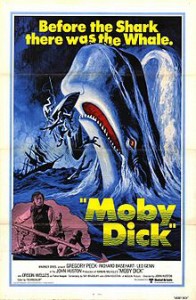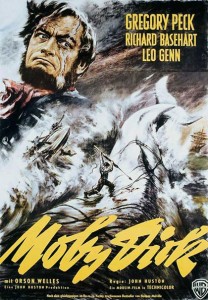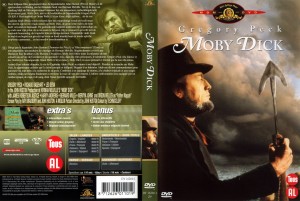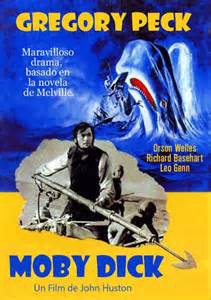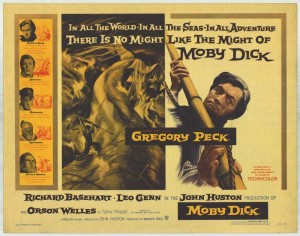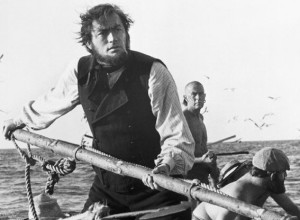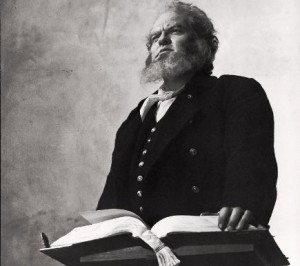Moby Dick *** (1956, Gregory Peck, Richard Basehart, Leo Genn, Orson Welles, Harry Andrews, James Robertson Justice, Bernard Miles, Mervyn Johns) – Classic Movie Review 2752
Co-writer/director John Huston’s intelligent and entertaining but only half-successful 1956 film version of the legendary Herman Melville classic novel stars Gregory Peck as one-legged ship’s Captain Ahab who obsessively pursues his adversary, the great whale who took his leg. It is a remake of a 1930 version with John Barrymore, who there reprises his role in the earlier 1926 silent version The Sea Beast.
The hard-working but miscast star Peck is unfortunately as wooden and uncomfortable as his peg leg and the pace is slack in an over-sedate, too carefully steady movie. Indeed, Peck felt Huston had deceived him into taking a part for which Peck felt he was ill-suited. He was not Huston’s choice for Ahab and was forced on him by the producing Mirisch brothers to gain finance for the movie.
However, the film is packed with engaging star support turns (especially from Orson Welles as Father Mapple, James Robertson Justice as Captain Boomer and Bernard Miles as Manxman), memorable images and involving production designs.
It also stars Richard Basehart as Ishmael, Leo Genn, Friedrich Ledebur and Harry Andrews. The score is by Philip Sainton.
The ideal vintage artefacts, costumes and backgrounds summon up the right 1840s period, mood and atmosphere. The action climax is extraordinary and exciting, even though the whale is as plastic as the shark in Jaws. And, above all, thanks to Oswald Morris’s lovely Technicolor cinematography, it always looks a treat.
Also in the cast are Noel Purcell, Edric Connor, Joseph Tomelty, Mervyn Johns, Francis de Woolf, Philip Stainton, Royal Dano, Tom Clegg and Seamus Kelly.
Screen-writer Ray Bradbury told Huston about Melville’s novel that he had ‘never been able to read the damned thing’ and there was much tension and anger between the two during production. However, this is the only one of the three cinema versions that is faithful to the novel and uses its original ending.
The film went way over budget, from $2 million to around $4.4 million, and did not recoup its costs on its initial release.
The film began shooting in Wales, then parts of the movie were shot at the sea in front of Caniçal, a traditional whaling parish in Madeira, with real action of whaling. It was also filmed in Las Canteras beach, Las Palmas de Gran Canaria, Canary Islands. Captain Alan Villiers commanded the ship for the film. Many exterior scenes set in New Bedford were shot on location in Youghal, County Cork, Ireland.
The whale shown in the film was indeed rubber, constructed by the tyre company Dunlop in Stoke-on-Trent, England. Moby Dick was 75 ft long and weighed 12 tons, and required 80 drums of compressed air and a hydraulic system to remain afloat and operational. The artificial whale came loose from its tow-line and drifted away in a fog when Peck was aboard the prop.
It was remade for TV in 1998 by director Franc Roddam, with Patrick Stewart, Henry Thomas, Bruce Spence and Gregory Peck again. It proved the last film appearance of Gregory Peck, this time in Welles’s old role as Father Mapple. He died in 2003.
It was remade again for TV in 2011 with William Hurt and Ethan Hawke.
At the age of four, Anjelica Huston met Peck dressed as Ahab when she visited the set of her father’s film. They met again decades later and became friends. Though John Huston and Peck fell out, she said that her father had ‘adored’ Peck.
Peck refused Steven Spielberg permission to use a clip from Moby Dick in his 1975 film Jaws as he was uncomfortable with his performance.
© Derek Winnert 2015 Classic Movie Review 2752
Check out more reviews on http://derekwinnert.com

